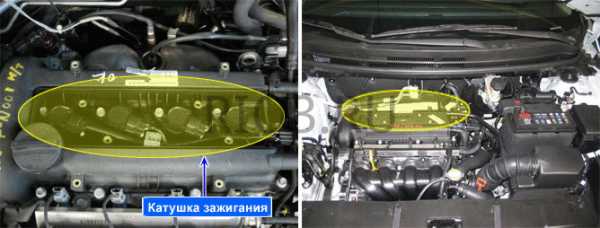
P0302 Cylinder 2 Misfire Detected
Content
Trouble Code P0302 OBD-II Datasheet
Ignition misfire detected in cylinder 2
What does this mean?
This Diagnostic Trouble Code (DTC) is a generic transmission code, which means it applies to OBD-II equipped vehicles. Although general in nature, the specific repair steps may differ depending on the brand / model. Car brands covered by this code may include, but are not limited to, VW, Chevrolet, Jeep, Dodge, Nissan, Honda, Ford, Toyota, Hyundai, etc.
The reason the P0302 code is stored in your OBD II vehicle is because the powertrain control module (PCM) has detected a misfire in a single cylinder. P0302 refers to cylinder number 2. Consult a reliable vehicle information source for the location of cylinder number 2 for the vehicle in question.
This type of code can be caused by a fuel supply problem, a large vacuum leak, an exhaust gas recirculation (EGR) system malfunction, or a mechanical engine failure, but is most often the result of an ignition system malfunction resulting in little or no spark. condition.

Almost all OBD II vehicles use a distributorless high-intensity spark ignition system, a coil-spark plug (COP) ignition system. It is controlled by the PCM to ensure accurate spark ignition and timing.
The PCM calculates inputs from the crankshaft position sensor, camshaft position sensor, and throttle position sensor (among others, depending on the vehicle) to tune the ignition timing strategy.
In a real sense, the camshaft position sensor and crankshaft position sensor are vital to the operation of the OBD II ignition system. Using inputs from these sensors, the PCM outputs a voltage signal that causes the high intensity ignition coils (usually one for each cylinder) to fire in sequential order.
Since the crankshaft rotates at about twice the speed of the camshaft (s), it is very important that the PCM knows their exact position; both in general and in relation to each other. Here's a simple way to explain this aspect of engine performance:
Top dead center (TDC) is the point at which the crankshaft and camshaft(s) are aligned with the piston (for cylinder number one) at its highest point and the intake valve(s) (for cylinder number one) are open. This is called the compression stroke.
During the compression stroke, air and fuel are drawn into the combustion chamber. At this point, an ignition spark is required to cause a fire. The PCM recognizes the position of the crankshaft and camshaft and provides the voltage signal required to generate a high intensity spark from the ignition coil.
Combustion in the cylinder pushes the piston back down. When the engine goes through a compression stroke and the number one piston begins to retrace to the crankshaft, the intake valve (s) close. This starts the beat of the release. When the crankshaft makes another revolution, the number one piston reaches its highest point again. Since the camshaft (s) have only made half a turn, the intake valve remains closed and the exhaust valve is open. At the top of the exhaust stroke, no ignition spark is required as this stroke is used to push the exhaust gas out of the cylinder through the opening created by the open exhaust valve (s) into the exhaust manifold.
Typical high intensity ignition coil operation is achieved with a constant supply of fused, switchable (only present when the ignition is on) battery voltage and a ground pulse supplied (at the appropriate time) from the PCM. When a ground pulse is applied to the ignition coil (primary) circuit, the coil emits a high intensity spark (up to 50,000 volts) for a fraction of a second. This high-intensity spark is transmitted through the spark plug wire or shroud and the spark plug, which is screwed into the cylinder head or intake manifold where it contacts the precise air/fuel mixture. The result is a controlled explosion. If this explosion does not occur, the RPM level is affected and the PCM detects it. The PCM then monitors camshaft position, crankshaft position, and individual coil feedback voltage inputs to determine which cylinder is currently misfiring or misfiring.
If the cylinder misfire is not persistent or severe enough, the code may appear pending and the malfunction indicator lamp (MIL) may only flash when the PCM actually detects a misfire (and then goes out when it is not). The system is designed to alert the driver that an engine misfire of this degree could harm the catalytic converter and other engine components. As soon as the misfires become more persistent and severe, P0302 will be stored and the MIL will remain on.
Code severity P0302
Conditions that favor the storage of P0302 can damage the catalytic converter and / or engine. This code should be classified as serious.
Symptoms of code P0302
P0302 symptoms may include:
- Reduced engine performance
- Feeling rough or unstable from the engine (idling or slightly accelerating)
- Strange engine exhaust smell
- Flashing or steady MIL (malfunction indicator lamp)
Causes of the P0302 code
The P0302 code may mean that one or more of the following events have occurred:
- Defective ignition coil (s)
- Bad spark plugs, spark plug wires, or spark plug anthers
- Defective fuel injectors
- Faulty fuel delivery system (fuel pump, fuel pump relay, fuel injectors, or fuel filter)
- Serious engine vacuum leak
- EGR valve stuck in fully open position
- Exhaust gas recirculation ports clogged.
Diagnostic and repair stages
Diagnosing a stored (or pending) P0302 code will require a diagnostic scanner, a digital volt / ohm meter (DVOM), and a reliable source of vehicle information.
- Begin your diagnosis by visually inspecting the damaged ignition coil, spark plug, and spark plug boot.
- Fluid contaminated components (oil, engine coolant, or water) must be cleaned or replaced.
- If the recommended maintenance interval requires (all) replacement of the spark plugs, now is the time to do so.
- Inspect the primary wiring and connectors of the corresponding ignition coil and repair if necessary.
- With the engine running (KOER), check for a large vacuum leak and repair if necessary.
- If Lean Exhaust Codes or Fuel Delivery Codes accompany a misfire code, they must be diagnosed and repaired first.
- All EGR valve position codes must be corrected before a misfire code is diagnosed.
- Insufficient EGR flow codes must be eliminated before diagnosing this code.
After fixing all the above problems, connect the scanner to the vehicle diagnostic port and retrieve all stored codes and freeze frame data. I like to write this information down as it may be useful later. Now clear the codes and see if P0302 resets during an extended test drive.
If the code is cleared, use your vehicle information source to search for technical service bulletins (TSBs) that relate to the symptoms and codes in question. Since TSB lists are compiled from many thousands of repairs, the information found in the corresponding list is likely to help you in making the correct diagnosis.
Take care to find the cylinder that is leaking ignition. Once this is done, you must determine the exact cause of the problem. You can spend many hours testing individual components, but I have a simple system for this task. The described procedure applies to a vehicle equipped with an automatic transmission. Manual transmission vehicles can also be tested in this way, but this is a more complicated way.
It looks like this:
- Determine which rpm range is most likely to misfire. This can be done by test driving or checking freeze frame data.
- After determining the RPM range, start the engine and allow it to reach normal operating temperature.
- Install chocks on both sides of the drive wheels of the vehicle.
- Have an assistant sit in the driver's seat and move the gear selector to the DRIVE position with the parking brake engaged and his foot firmly pressing the brake pedal.
- Stand close to the front of the vehicle so you can reach the engine with the hood open and secure.
- Have the assistant increase the rev level gradually by depressing the accelerator pedal until a misfire appears.
- If the engine stops working, CAREFULLY raise the ignition coil and pay attention to the degree of spark formation of a high intensity.
- The high intensity spark should be bright blue in color and have tremendous power. If not, suspect the ignition coil is faulty.
- If you are unsure of the spark produced by the coil in question, lift the known good coil from its place and observe the spark level.
- If it is necessary to replace the ignition coil, it is recommended to replace the corresponding spark plug and dust cover / wire.
- If the ignition coil is working properly, shut off the engine and insert a known good spark plug in the shroud / wire.
- Restart the engine and ask the assistant to repeat the procedure.
- Observe a strong spark from the spark plug. It should also be bright blue and rich. If not, suspect that the spark plug is faulty for the corresponding cylinder.
- If a high intensity spark (for the affected cylinder) seems normal, you can perform a similar test on the fuel injector by carefully disconnecting it to see if any difference in engine speed is found. A running fuel injector will also make an audible ticking sound.
- If the fuel injector is not working, use the assembly indicator to check the voltage and ground signal (at the injector connector) with the engine running.
In most cases, you will have found the cause of the misfires by the time you finish testing the high intensity spark.
- Exhaust gas recirculation systems that use a single cylinder exhaust gas injection system are known to cause symptoms that mimic a misfire condition. The cylinder portals of the exhaust gas recirculation are clogged and cause all the exhaust gas recirculation gases to be dumped into one cylinder, resulting in a misfire.
- Use caution when testing high intensity sparks. Voltage at 50,000 volts can be dangerous or even fatal under extreme circumstances.
- When testing a high intensity spark, keep it away from fuel sources to avoid disaster.
HOW DOES A MECHANIC DIAGNOSTIC CODE P0302?
- Uses an OBD-II scanner to collect freeze frame data and stored trouble codes from the transmission control module.
- See if DTC P0302 returns when you test drive the vehicle.
- Inspects cylinder 2 spark plug wire for frayed or damaged wires.
- Inspects spark plug housing 2 for excessive wear or damage.
- Inspects coil pack wires for frayed or damaged wires.
- Inspect the coil packs for excessive wear or damage.
- Replace damaged spark plugs, spark plug wires, coil packs, and battery wiring as needed.
- If DTC P0302 returns after replacing damaged spark plugs, batteries, spark plug wires and battery wiring, they will check the fuel injectors and fuel injector wiring for damage.
- For vehicles with a distributor cap and rotor button system (older vehicles), they will inspect the distributor cap and rotor button for corrosion, cracks, excessive wear, or other damage.
- Diagnose and correct any other related trouble codes stored in the transmission control module. Runs another test drive to see if DTC P0302 reappears.
- If DTC P0302 returns, a 2-cylinder compression system test will be performed (this is not common).
- If DTC P0302 still persists, the problem may be with the Powertrain Control Module (rare). May require replacement or reprogramming.
COMMON ERRORS WHEN DIAGNOSING CODE P0302
Visually inspect the fuel injector harness for damage before replacing spark plugs, coil packs, or spark plug and battery harnesses. If applicable, diagnose and repair any other related trouble codes present. Also remember to rule out the bad cylinder as the cause of the problem.
Any of these components can cause DTC P0302. It is important to take your time to rule out all possible causes of a misfire code when diagnosing it. Working with them during this process will save a lot of time.
ADDITIONAL COMMENTS TO BE AWARE OF CODE P0302
If one of the spark plugs needs to be replaced, replace the other spark plugs as well. If one of the coil packs needs to be replaced, the other coil packs do not need to be replaced either. This type of code usually indicates that the car needs tuning, so replacing the spark plug usually doesn't fix the problem.
To quickly determine if a wire or coil pack failure is causing the misfire, swap the wires or battery for cylinder 2 with wires from a different cylinder or coil pack. If a DTC for this cylinder is stored in the transmission control module, it indicates that a wire or coil pack is causing the misfire. If there are other misfiring fault codes, they must be diagnosed and repaired.
Make sure the spark plugs have the correct gap. Use a feeler gauge to ensure the exact gap between the spark plugs. Incorrect spark plug placement will result in new misfiring. Spark plugs should be adjusted to the manufacturer's specifications. These characteristics can usually be found on a sticker under the hood of a car. If not, these specifications can be obtained from any local auto parts store.
Need more help with the P0302 code?
If you still need help with DTC P0302, post a question in the comments below this article.
NOTE. This information is provided for informational purposes only. It is not intended to be used as a repair recommendation and we are not responsible for any action you take on any vehicle. All information on this site is protected by copyright.

3 comment
gerbelia
How do you know which cylinder it is? Number 2 in firing order, or number 2 in location? Concerns a Volkswagen Golf as far as my question is concerned.
Fabio Santos
as if cylinder number 1 2 3 and 4 in order.?
Mitya
The misfire of the 2nd cylinder appears periodically, I turned off the engine, started it, the misfires disappeared, the engine runs smoothly! Sometimes restarting the engine does not help, in general it happens as it wants! It might not work for a day or two, or it might miss the 2nd cylinder all day! misfires appear at different speeds and in different weather, be it frost or rain, at different engine temperatures from cold to operating temperature, regardless, I changed spark plugs, changed coils, changed injectors, washed the injector, connected it to the fuel pump, adjusted the valves, no changes!